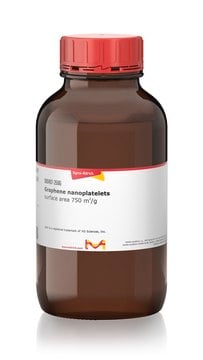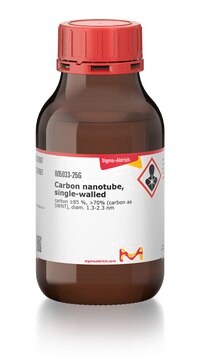719811
Kohlenstoff-Nanofasern
pyrolitically stripped, platelets(conical), >98% carbon basis, D × L 100 nm × 20-200 μm
Synonym(e):
Kohlenstoff Nanofasern, konisch
About This Item
Empfohlene Produkte
Biologische Quelle
platelets (conical)
Assay
>98% carbon basis
Form
powder
Grünere Alternativprodukt-Eigenschaften
Design for Energy Efficiency
Learn more about the Principles of Green Chemistry.
sustainability
Greener Alternative Product
T × L
100 nm × 20-200 μm
Oberflächenbereich
54 m2/g
Verunreinigungen
<14,000 ppm Iron content
Durchschnittlicher Durchmesser
130 nm
Porengröße
0.12 cm3/g average pore volume
89.3 Å average pore diameter
mp (Schmelzpunkt)
3652-3697 °C
Dichte
1.9 g/mL at 25 °C
Schüttdichte
0.5‑3.5 lb/cu.ft
Grünere Alternativprodukt-Kategorie
SMILES String
[C]
InChI
1S/C
InChIKey
OKTJSMMVPCPJKN-UHFFFAOYSA-N
Suchen Sie nach ähnlichen Produkten? Aufrufen Leitfaden zum Produktvergleich
Allgemeine Beschreibung
Anwendung
Angaben zur Herstellung
Rechtliche Hinweise
Signalwort
Warning
H-Sätze
Gefahreneinstufungen
Eye Irrit. 2 - STOT SE 3
Zielorgane
Respiratory system
Lagerklassenschlüssel
11 - Combustible Solids
WGK
WGK 3
Flammpunkt (°F)
Not applicable
Flammpunkt (°C)
Not applicable
Hier finden Sie alle aktuellen Versionen:
Besitzen Sie dieses Produkt bereits?
In der Dokumentenbibliothek finden Sie die Dokumentation zu den Produkten, die Sie kürzlich erworben haben.
Kunden haben sich ebenfalls angesehen
Artikel
Pyrograf®-III vapor-grown carbon nanofibers are within the class of materials termed multi-walled carbon nanotubes (MWCNTs), and are produced by the floating catalyst method.
Composite materials that traditionally incorporate micron scale reinforcements in a bulk matrix offer opportunities to tailor material properties such as hardness, tensile strength, ductility, density, thermal and electrical conductivity, and wear resistance.
3D printing is a type of additive manufacturing that can be used to rapidly fabricate components with highly customizable geometries.
Unser Team von Wissenschaftlern verfügt über Erfahrung in allen Forschungsbereichen einschließlich Life Science, Materialwissenschaften, chemischer Synthese, Chromatographie, Analytik und vielen mehr..
Setzen Sie sich mit dem technischen Dienst in Verbindung.






